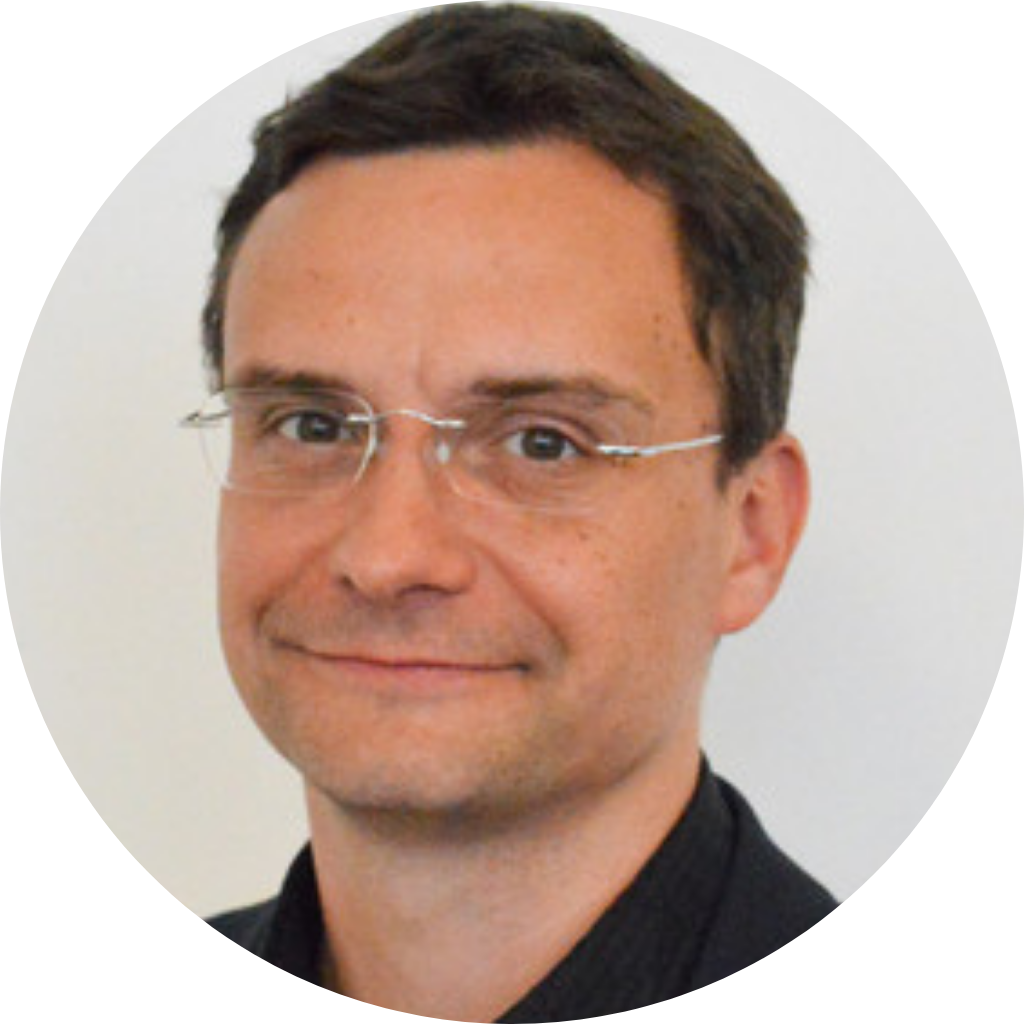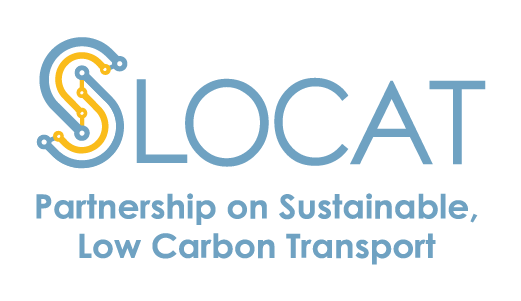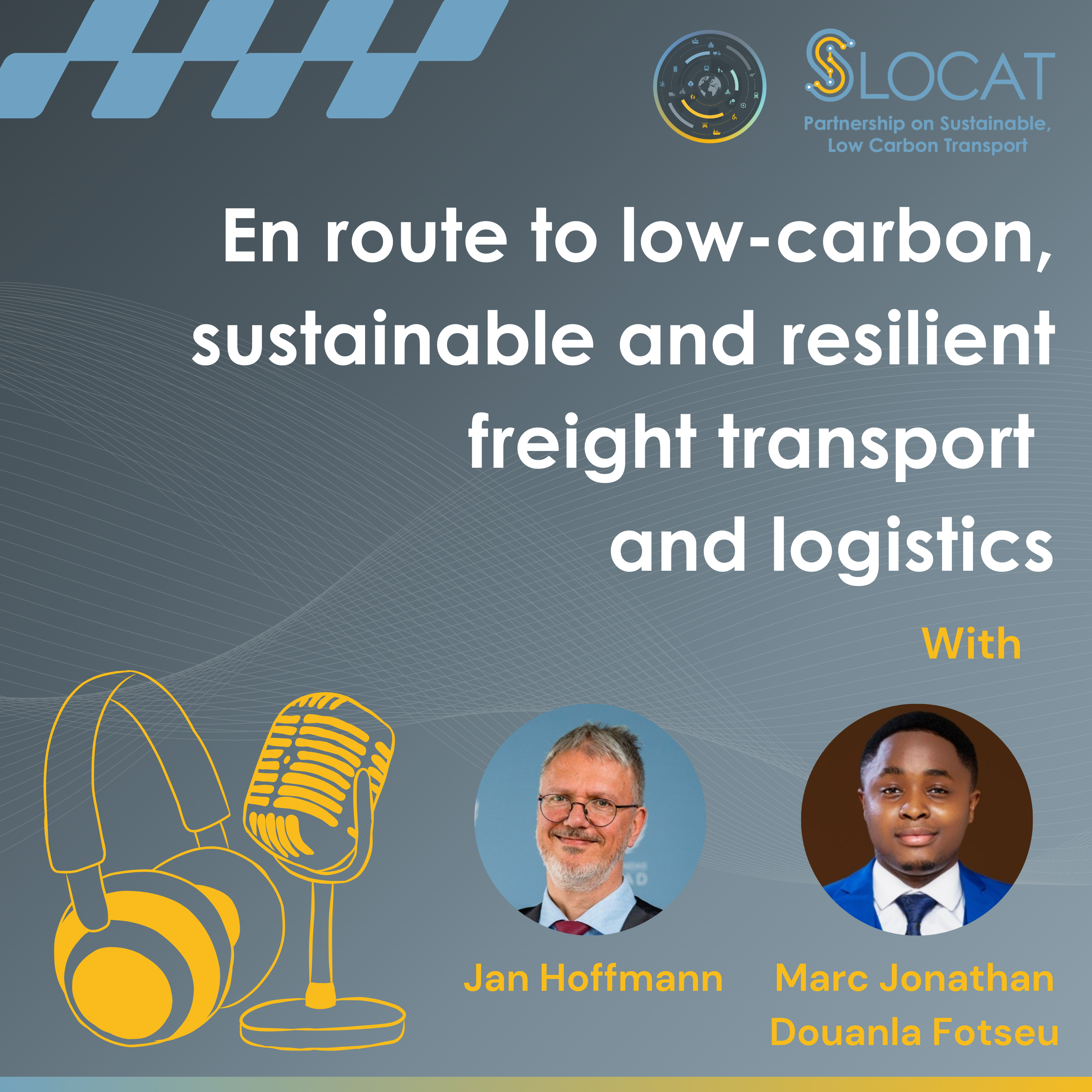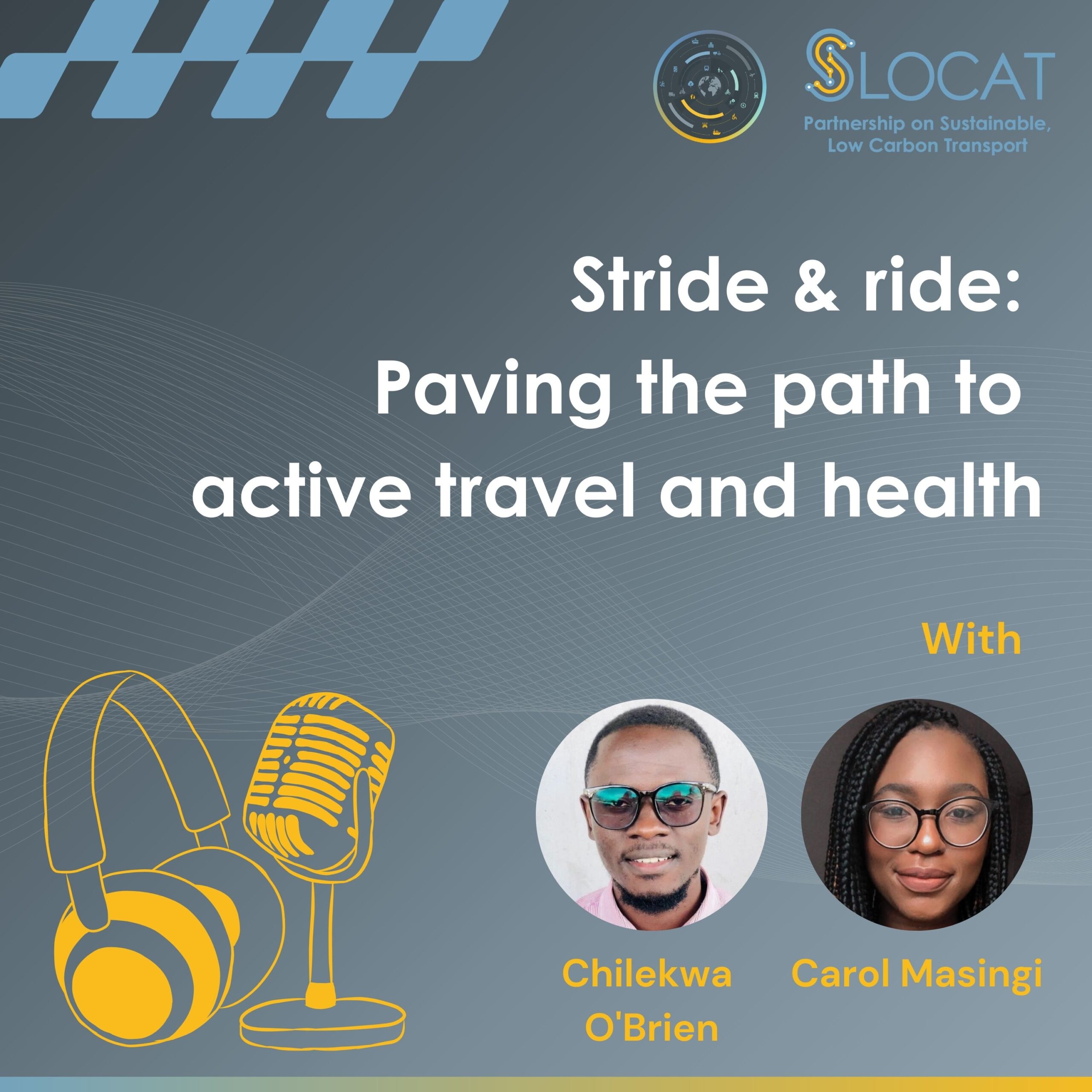Tough Questions, Smart Answers on All Things Transport, People and Planet
Integrating urban electric mobility solutions - What does it take?
Join our speakers!

Oliver Lah
Head of the Mobility and International Cooperation Unit
Wuppertal Institute

María Rosa Muñoz
Senior Researcher
Wuppertal Institute

Spencer S. Taylor, Jr.
Director of Climate Change
and Environment
Ministry of Transport in Liberia
About this episode
Jump into the insightful conversation between Mr. Oliver Lah, Head of the Mobility and International Cooperation Unit, Wuppertal Institute, Ms. María Rosa Muñoz, Senior Researcher at the Wuppertal Institute and Mr. Spencer S. Taylor, Jr., Director of Climate Change and Environment, Ministry of Transport in Liberia!
Throughout the episode, they go over SOLUTIONSplus’ global efforts in implementing sustainable e-mobility solutions across Asia, Africa, and Latin America. Oliver outlines their approach, involving 48 partners in testing innovative e-mobility solutions, collaborating with local entrepreneurs, cities, and academics to ensure viability and scalability. Rosa introduces their Urban Living Labs method, emphasising the integration of diverse stakeholders to develop business models, policy frameworks, and conduct impact assessments are crucial for sustainable mobility transitions.
We invite you to listen to their lively conversation now!
Transcript
0:00:10.06
I am your host, Spencer S. Taylor, Jr, a SLOCAT-VREF young leader in sustainable transport and the director of the division of climate change and environment at the Ministry of Transport in Liberia. Today we are joined by 2 esteemed guests. Mr. Oliver Lah and Ms. María Rosa Muñoz. Both from the Wuppertal Institute and SOLUTIONSplus consortium. They will share their insights on integrating urban electric solutions. We set the stage for a transition towards a low-carbon urban mobility. We will also hear hands-on stories on how SOLUTIONSplus integrates different types of e-mobility in large urban areas that address user needs and local conditions in Latin America, the Caribbean and other parts of Europe, Asia and Africa.
Oliver, Maria. Thank you for accepting our invite and welcome to the podcast.
0:01:28.02
Oliver Lah: Thanks, Spencer for having us. Great to be here.
0:01:32.24
Spencer S. Taylor, Jr.: So let’s dive right in. Now, let’s begin with Oliver.
Oliver. Can you give us a brief overview of how the work and impact of SOLUTIONSplus initiatives are implemented across different regions in the world?
0:01:47.91
Oliver Lah: Great thanks, Spencer, so much appreciated, and also, thanks to our friends SLOCAT for facilitating that exchange. So yeah, SLOCAT is part of the SOLUTIONSplus consortium, a big family of 48 partners, where we’ve worked over the last 4 and a half years in Asia, Africa, and Latin America. We had 9 plus one, let’s say, primary Living Labs where we tested innovative mobility solutions. And then over 20 replication cases. And we’re focusing here on passenger and freight transport. So basically everything but the individual car. And we work with local entrepreneurs, with cities, with national authorities, with local academic partners to facilitate those teams of change. And we’ve just finished our final conference. And we’re now in that process of bringing all of the learnings into knowledge products to foster replication and exchange.
0:02:56.09
Spencer S. Taylor, Jr.: Oh, yeah, that’s quite fascinating. Thank you. So yeah, let’s hear from Maria. Maria. Please tell us what are the key factors that are required to successfully integrate urban electric mobility solutions to achieve sustainable mobility outcomes. Can you give us your insight?
0:03:18.21
We’ve also been working on policy development, on identifying financial solutions for the scale app and also working on documents, such as city roadmaps that can lead the way for the scale up of these types of solutions. So this is more or less the context in which we have been working. There has also been an impact assessment, a very comprehensive impact assessment, so that all the learnings from these pilots that we implemented in these 20+ cities, can be taken forward in the same cities, in the same countries where we work, but also everywhere else in other cities in the globe. So that’s more or less the approach that we had in the context of SOLUTIONSplus.
0:04:49.69
Spencer S. Taylor, Jr.: Oh, incredible! You are doing an amazing job across the globe. Yes. So you mentioned about impact assessment that you are conducting. So can you relist some of the impacts that your work has achieved across various regions.
0:05:09.22
Oliver Lah: Maybe I can like, you know, just to to start a little bit to share listeners what we’re actually talking about because we talked about e-mobility, and the first thing that comes to mind like a Tesla roaming down the the street. So this is the e-mobility that we are not doing. And when we talk about e-mobility, we talk about electric 2 and 3 wheelers. So scooters, motorbikes tuk tuks, mini vans, mini buses, and all of which are for shared and public transport, and the key bit, of course, that we would need to do to convince businesses and investors, and that the business model of the producer is viable is an impact assessment that the product is something that is fit for purpose. So we test it. That’s what the Living Labs that Rosa talked about are so important about. So we’ll reduce the vehicle and then use it in a real life environment. And then, of course, it’s about making numbers, right? So that model of that electric 3 wheeler, for example, in Kathmandu, for example, that is being used for passenger transport and freight transport under different use cases performs better than a petrol driven. And that’s what our various friends, the consortium worked on with our city partner.
0:06:42.52
Spencer S. Taylor, Jr.: Oh, great! Thank you, Mr. Oliver, for that insight. So also I was thinking, what lessons can other countries, like my country Liberia, whose transport sector is largely supported by 2 and 3 wheelers, learn from SOLUTIONSplus experience in implementing e-mobility solutions for a more efficient, vibrant, competitive, and sustainable transport sector. How can we learn from your, I mean, from the work you do? From your experience.
0:07:13.41
Oliver Lah: Great! Rosa, would you like to start?
0:07:17.22
We realised that there are actually the capacities for the local manufacturing, or at least assembly, of these types of vehicles. Then we worked together with other local stakeholders, such as academia, that provided a great insight into how to design the pilot, how to integrate the private sector as well. They already had linkages, and so on. So we worked together with the manufacturers, the start-ups. We worked together with the academia. We worked together with the private sector, so the operators as such, and we also had the support of the local authorities. So with this ecosystem of stakeholders. We were able to push these processes forward. And really, I think that that’s one of the best learnings that we can share with other cities. In order to start the transition.
0:08:44.76
Oliver Lah: And maybe a critical element to right here, just from the perspective, why we take it from that perspective, is that we would like to turn the whole story about climate action into something that is related to opportunities. It’s not a burden. It’s not something that we have to do. But actually, we don’t want to. But it’s something that can create jobs. It can create opportunities in particular for countries like Liberia. And you know, usually having an industry in that field of mobility can become an opportunity to venture into the production vehicles. Right? So usually, it’s the U.S., France, Germany, the usual suspect with regard to the vehicle industry. But with a redistributed way of basically, everyone can get into the e-mobility is fair, in 2 and 3, as in particular. This can turn into an industrial and economic development opportunity. And this is the spin that we would like to give it to.
0:09:49.87
Spencer S. Taylor, Jr.: Great. And so that’s quite interesting. And so I’m so much interested in this topic. Okay, so I actually want to know what actually is going to take to get a SOLUTIONSplus to replicate its initiative or activities in countries like mine or any other country that is going to have interest in, you know, implementing the 2 and 3 wheelers in their transport system. So what is going to take to have SOLUTIONSplus replicate those initiatives in our countries.
0:10:26.37
Oliver Lah: So interested participants definitely can check out the e-mobility toolbox and the SOLUTIONSplus website where we are sharing all knowledge products that we’ve created and are finishing up at the moment. Here you can also find the insights from each of the Living Lab where we went through that restructured process there we’ve had throughout the project, and also some very specific guidance for project implementers, so that you, from a Ministry’s perspective, can also, encourage actors like the World Bank and others in in the field who may want to approach you for a project in that field, e-mobility field, and to take up the learnings and then say, well, you know there are some practical blueprints for businesses, for vehicles for their operations. Why don’t you inhale that into your project design? And then we can work with you in that structured approach that these guys take. Because we would like to make this as easy as possible to replicate basically the project and all the businesses and vehicle concepts that we’ve worked on.
0:11:46.29
And so we have great learnings in terms of efficiency in terms of cost that we didn’t think we would have at the beginning, or we faced partners that were very sceptical about the use of these vehicles, for example, in logistics operations. But we now have these learnings, and what we identified also is that there are a lack of policies to enable these vehicles to operate formally in cities. So that’s for us. We, of course, left some guidance about the policies that need to be taken up in order to promote the use of these vehicles in cities. But more has to be done by local and national governments in order to integrate them in the systems as formal actors, and promote their use as a contribution to sustainable urban mobility, that they are.
0:13:08.19
Spencer S. Taylor, Jr.: Okay, great. So yeah. So some of the policies, could one of them be, maybe the formulation of a zero-emission vehicle policy? Is it going to help guide the adoption of e-vehicles in the country? I’m posing this question specifically because we are in the process of formulating this policy. All right, we are at the genesis of it. This is the beginning, all right. So I really want to know whether I mean these e-vehicles policies that we are about to formulate can help guide that process.
0:13:48.79
Oliver Lah: Absolutely. It’s great framing. I would like to say, though, that policy alone will not do the trick, right? So it is quite important also for the national government to get into the driver seat to actually seek the local opportunities because, the likely cases, then, of course, that you know, big exporters will identify those countries that have those policies and you will receive cheap foreign products from there, you know. Obviously, it’s usually a Chinese product that is not necessarily fit for the local conditions, right? And we see that a lot of vectors come onto the market. They drop cheap products to partner countries, and they are not fit for purpose. With regard to the climate conditions with regard to the road conditions. And if you were to be able to get into the driver seat on development of a local industry, that’s quite a different opportunity, right? That you can seek. So local job and value creation is way much higher than just purely on the receiving, importing it. So policy is an important start and framing, but a quite proactive role in developing a local ecosystem is another critical element.
0:15:18.51
Spencer S. Taylor, Jr.: Thank you. Quite interesting. So back to Maria. So why are sheer public and commercial e-mobility solutions so crucial for urban areas in Latin America and any other countries that you are currently implementing your initiatives. Why are they so important?
0:15:39.60
But then there’s another sector where we focus mainly, which is the urban logistics sector, and that’s the long forgotten sector in mobility, and also from a policy perspective, because it’s seen as a sector that is led by the private sector, and therefore doesn’t need so much guidance. But it does. So as a matter of fact, it is estimated that in cities worldwide freight vehicles represent an average. 25% of the total vehicle fleet occupy 40% of the road space and are responsible for between 30 and 50% of the main air pollutant and contribute up to 40% of the greenhouse gas emissions. So it is an important sector to be considered in urban policies. And so in the context of SOLUTIONSplus, we work with different types of light electric vehicles. So we had 15 different types of vehicles manufactured by 11 start-ups from different countries. We had 12 different use cases mainly in logistics, but also in passenger transport. And we had a total of 2 demonstration series and 10 replication series, where these vehicles were tested with very interesting results that then we can push forward, towards a change, not only in the type of vehicle. It’s a change in the way they operate in the way cities are configured in the way infrastructure is planned, because if more light electric vehicles are going to come on the streets, that means also their space needs to be redistributed in a more inclusive way, so that they can circulate safely without putting other users, other vulnerable users of the road, at risk.
0:18:35.87
Spencer S. Taylor, Jr.: Hmm! Quite exciting! Thank you. So Oliver. So I’m quite aware that SOLUTIONSplus initiatives have been implemented in other areas, including Kigali, Dar es Salaam, Hamburg, and Hanoi. So can you kindly tell us, how did SOLUTIONSplus get to extend its successful projects across these regions?
0:19:05.15
Oliver Lah: Cause, I mean, the entire idea about the first selection of the first Living Labs was to have a very diverse mix of solutions and operating environments. So that’s why they are as diverse as Hamburg, Kigali and Madrid and Montevideo and Pasig, The Metro Manila region, and Quito, so quite different operating environments and quite different vehicles and services that we delivered there across the 4 and a half years of our operations. And the reason was to have as much as possible experiences from those processes. So with regard to very different local and national, regulatory and policy environments, but also the capacities that you have in the partner institutions and the solutions that we take so that we can take that and digest. and we’ve had already a big replication round in the second half of the project we’ve sprawled across the region into projects of our sister project that is run by the United Nations Environment’s programme and funded by the Global Environment Facility. And that programme continues to run and is now involving over 50 countries where we can bring in all the learnings from SOLUTIONSplus on specific technological solutions that we worked on the business cases. But then, also how that interplay works with the regulatory and policy environment. So we’re basically replication ready. So you know, reach out, get involved into the Global Environment Facility’s programme where that is possible from your country as well. You know Liberia might be already exploring options there. But of course, also other funding opportunities that are around, and then, having that easy entry level with regard to solutions ready for take up is also interesting for any other funder in the field.
0:21:19.86
Spencer S. Taylor, Jr.: Oh, that’s quite interesting. Yeah, of course, Liberia is ready. So yeah to Ms. Muñoz.
0:21:26.97
Oliver Lah: Good to hear!
0:21:28.23
Spencer S. Taylor, Jr.: So given, the extensive initiatives of SOLUTIONSplus across the globe. Were there obstacles and prospects involved in expanding your replication efforts across those regions? And you’d like to speak to that, Rosa?
0:21:48.40
0:24:15.44
Oliver Lah: Great! You summarised it very nicely. So, yeah, I mean, I think, the platforms and the programme continues to be there. The initiative that coordinated SOLUTIONSplus or electric mobility initiative that will also continue activities on different components on public transport. And a programme called eBRT2030, together with the network UITP, and many other partners that are also regional programmes in Africa, Asia, and Latin America, and where this is being followed on. And then again, as I said, the sister program or by the Global EnvironmentFacility will also continue to support countries and share learnings. So yeah, the train continues for sure.
0:25:07.92
Spencer S. Taylor, Jr.: Great! Yeah. So I would just like to reveal also that I mean Liberia also has the same problem. Public acceptability of this new mode of transition into this new mode of transport is an issue. So what we are doing currently is building capacities. We are increasing awareness, and all of that. So I’m quite aware of that obstacles. So yeah, we want to thank you both for sharing your insights today. It has been enlightening to learn about the incredible work you are doing. Yeah. So that concludes today’s episode of SLOCAT podcast series: Voices across generations of changemakers.
To our esteemed listeners. We want to say thank you for joining us, and I encourage you to tune in for upcoming episodes to learn more about sustainable transport solutions implemented across the world. Oliver, Maria, thank you for your insights.
0:26:07.44
Oliver Lah: Thanks. Spencer, greatly appreciated.
0:26:10.40


